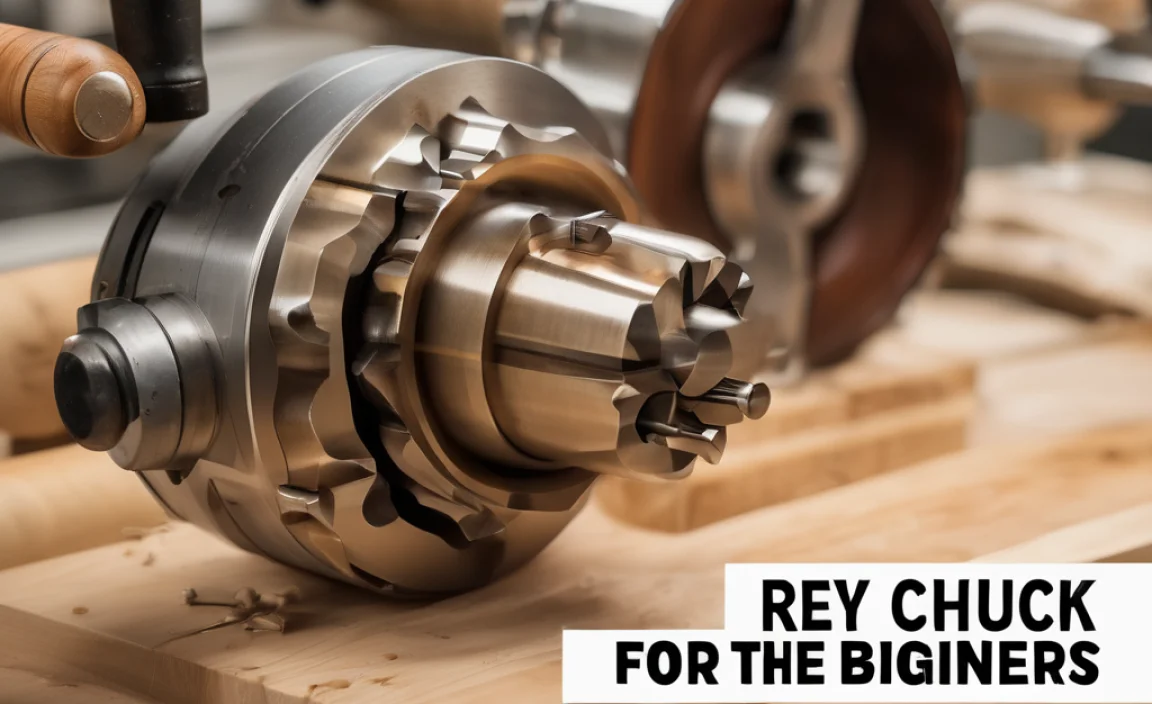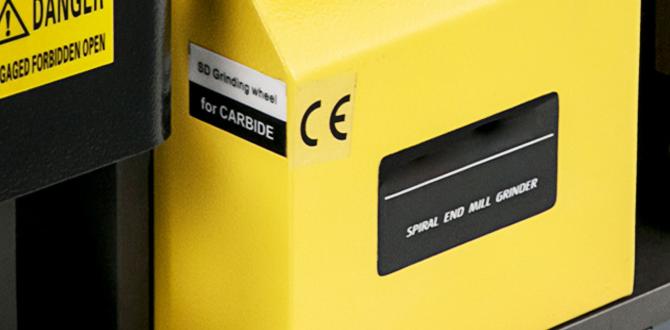Quick Summary
Choosing the right cutting tools for your lathe is crucial for smooth, accurate cuts. This guide breaks down the essential types, materials, and geometries for beginners, ensuring you get the best results and a clean finish on your projects. Learn what you need to start turning like a pro!
Welcome to Lathe Hub! If you’re new to the world of lathes, you might find yourself a bit overwhelmed by all the different cutting tools available. It’s easy to feel lost when you’re just starting out, looking at a bewildering array of shapes and sizes. But don’t worry! Understanding these essential tools is one of the most important steps to mastering your lathe. With the right knowledge, you’ll be creating smooth, precise work in no time. Let’s demystify these vital pieces of equipment and get you turning with confidence.
The Heart of the Matter: Understanding Lathe Cutting Tools
A lathe’s power lies in its ability to spin a workpiece while a sharp cutting tool shaves away material. This process, called turning, allows you to create precise cylindrical shapes, threads, and complex contours. The cutting tool is the direct interface between your idea and the finished part. Getting it right means cleaner cuts, less effort, and a much more enjoyable experience.
For beginners, the goal is to understand the fundamental types of tools and what makes them effective. We’ll cover the basic shapes, the materials they’re made from, and how to select the right one for common tasks. Think of these tools as your hands on the lathe; you need the right grip, the right leverage, and the right purpose for each.
Essential Cutting Tools Every Lathe User Needs
When you’re starting, you don’t need a massive collection of specialized tools. A few well-chosen essentials will cover most basic turning operations. These are the workhorses that will help you learn the fundamentals of material removal and shaping.
1. The Roughing Gouge
This is often your first tool for shaping raw material. Its curved cutting edge is perfect for quickly removing large amounts of material, turning a square or rectangular blank into a rough cylinder. It’s your main tool for creating the basic form of your workpiece.
- Shape: Deep, U-shaped flute.
- Purpose: Bulk material removal, rounding stock.
- Beginner Tip: Use a slicing motion, letting the tool do the work. Don’t force it.
2. The Spindle Gouge (or Detail Gouge)
Once you have your basic shape, the smaller spindle gouge comes into play. With a narrower flute and a more pointed tip, it’s designed for finer work. You’ll use this for creating details, curves, beads, and coves on linear pieces like table legs or spindles.
- Shape: Shallower, narrower U-shaped flute than a roughing gouge, often with a more pointed tip.
- Purpose: Shaping finer details, curves, beads, and coves.
- Beginner Tip: Hold it at an angle for a slicing cut. Experiment with different flute angles for varied cuts.
3. The Skew Chisel
The skew chisel looks simple but is incredibly versatile. It has a flat blade with the edge ground at an angle, making it ideal for smoothing surfaces, scraping cuts, and creating fine details. It can seem tricky at first, but mastering the skew makes a huge difference to the finish of your work.
- Shape: Flat blade with the cutting edge ground at an angle (usually around 60 degrees).
- Purpose: Smoothing end grain and face grain, scraping cuts, creating chamfers and parallel surfaces.
- Beginner Tip: Learn to present the bevel to the wood for a shearing cut, which leaves a much smoother surface than a scraping cut.
4. The Parting Tool
This tool is designed to cut grooves and to separate (part off) finished pieces from the stock. It has a very narrow blade, which reduces friction and heat, allowing it to cut deeply without binding. It’s essential for creating sections, shoulders, and for cutting your workpiece free from the lathe.
- Shape: Very narrow, often rectangular blade with squared edges.
- Purpose: Cutting grooves, undercuts, and parting off work.
- Beginner Tip: Cut slowly and steadily. Ensure the tool is perfectly square to the workpiece to avoid binding.
5. The Scraper (or Flat Scraper)
Scrapers are flat tools used for smoothing surfaces, particularly end grain or in tight corners where gouges can’t reach. They don’t cut in the traditional sense; instead, they remove material by a scraping action. They’re great for achieving a very fine, smooth finish, especially on harder woods.
- Shape: Flat, often rectangular blade, sometimes with a slight curve or hook on the end.
- Purpose: Smoothing surfaces, especially end grain, removing tool marks, creating flat areas.
- Beginner Tip: Keep the tool flat and push it into the wood. A slight negative rake angle can help with a scraping cut.
Materials Matter: What Your Tools Are Made Of
The material of your cutting tool directly impacts its ability to hold an edge, resist heat, and cut effectively. For beginners, understanding these basic materials will help you choose tools that are durable and reliable.
High-Speed Steel (HSS)
This is the most common and generally recommended material for beginner lathe tools. HSS can withstand higher temperatures generated during cutting without losing its hardness and sharpness. This makes it more forgiving for new users who might be learning about feed rates and cutting speeds.
- Pros: Holds an edge well, can handle some heat, relatively affordable.
- Cons: Can dull faster than carbide with very aggressive cuts.
Carbide (Tungsten Carbide)
Carbide tools often come with replaceable tips. These tips are extremely hard and stay sharp for a very long time. They are excellent for demanding cuts, but the tips can be brittle and may chip if dropped or subjected to impact. Many modern turning tools for hobbyists feature interchangeable carbide inserts, offering versatility and ease of use.
- Pros: Extremely hard and stays sharp for a long time, often interchangeable tips.
- Cons: Can be brittle, more expensive upfront, can be limited in the specific cutting geometries available.
Tool Geometry: The Cutting Edge’s Secret Sauce
Beyond the material, the shape and angle of the cutting edge – its geometry – is critical. Different grinds and bevel angles are designed for specific tasks and materials.
Bevel Angle
The bevel angle is the angle of the cutting edge on the tool. A steeper angle (e.g., 30-40 degrees) is good for harder woods or finer finishing, while a shallower angle (e.g., 15-25 degrees) can be more aggressive and cut more easily, especially in softer woods.
Grind Types
- Convex Grind: The most common grind for gouges. The edge curves outward, making it strong and suitable for bulk removal.
- Flat Grind: Used on chisels and scrapers where a flat, sharp edge is needed.
- Scraping Grind: Often means creating a small hook or wire edge on the cutting tool to scrape material away.
For beginners, many tools come pre-ground, which is perfect. As you gain experience, you might explore sharpening and reshaping your tools yourself, and understanding these geometries will be key. Resources like Woodworker’s Source offer excellent guides on tool sharpening techniques.
Metal Lathe Cutting Tools: A Different Ballgame
While we’ve touched on woodturning tools, it’s important to note that metal lathe cutting tools are quite different. They require robust construction, specific cutting angles to manage heat and chip formation, and often use inserts made of carbide or HSS. The principles of material removal are similar, but the forces, speeds, and materials demand specialized tooling.
Metal lathe tools are generally made of solid HSS or feature carbide inserts held in place by a tool holder. They are designed to handle the immense forces and heat generated when cutting metal. Common types include:
- Round Nose Scrapers: For finishing and creating convex surfaces.
- Side Cutters (Right and Left Hand): For facing and shoulder cuts.
- Parting Tools: Similar to wood parting tools but designed for metal.
- Threading Tools: Specialized tools for cutting screw threads.
The geometry and application of these tools are complex and require dedicated study. For metalworking beginners, starting with a good quality HSS set is often recommended. The Mechanical Engineering department at MIT has extensive resources on machining processes and tooling, which can be a valuable deep dive for those interested.
| Tool Type | Primary Function | Material Focus (Wood/Metal) | Beginner Friendliness |
|---|---|---|---|
| Roughing Gouge | Bulk material removal, shaping rough blanks | Wood | High |
| Spindle Gouge / Detail Gouge | Fine shaping, curves, beads, coves | Wood | Medium |
| Skew Chisel | Smoothing, scraping, chamfers, fine cuts | Wood | Medium (learning curve) |
| Parting Tool | Cutting grooves, separating workpieces | Wood & Metal | High |
| Scraper (Flat) | Surface smoothing, finishing in tight spots | Wood | High |
| Solid HSS Lathe Tool | Turning, facing, threading (metal) | Metal | Medium |
| Carbide Insert Tool | Heavy cutting, high volume, varied operations (metal) | Metal | Medium (easy insert changes) |
Choosing Your First Set: What to Look For
As a beginner, you want tools that are easy to use, durable, and provide good results. Don’t feel the need to buy every tool you see. Start with a basic set that covers the fundamental operations.
For Woodturning Beginners:
A good starting point would be a set that includes:
- A Roughing Gouge (e.g., 1/2″ or 3/4″ sweep)
- A Spindle Gouge (e.g., 1/4″ or 3/8″ sweep)
- A Skew Chisel (e.g., 1/2″ or 3/4″ width)
- A Parting Tool (e.g., 1/8″ or 3/16″ width)
- A Scraper (e.g., a flat scraper or a round nose scraper)
These tools, typically made of HSS, will allow you to practice a wide range of techniques. Look for reputable brands that offer good value. Many manufacturers sell starter kits that bundle these essential tools together.
Safety First! Always Keep Safety in Mind
Machining, whether wood or metal, involves sharp tools and rotating machinery. Safety should always be your top priority. This means:
- Eye Protection: ALWAYS wear safety glasses or a full face shield.
- Appropriate Clothing: No loose clothing, jewelry, or long hair that can get caught.
- Tool Handling: Keep tools on their handles. Never touch the cutting edge.
- Tool Setup: Ensure tools are securely held in the tool rest or tool post.
- Workpiece Security: Make sure your workpiece is firmly mounted on the lathe.
- Sharp Tools: Dull tools require more force and are more dangerous. Keep your tools sharp.
Understanding how to use your tools safely is as critical as knowing which tool to use. The Occupational Safety and Health Administration (OSHA) provides extensive guidelines on machine operation safety that are universally applicable.
Sharpening Your Tools: The Key to Good Cuts
No matter how good your tools are, they will eventually become dull. Dull tools don’t cut; they tear and burn. This makes your job harder, produces poor results, and is a major safety hazard. Learning to sharpen your lathe tools effectively is one of the most rewarding skills you can develop.
There are several methods for sharpening:
1. Grinding Wheels
A bench grinder with appropriate grinding wheels (like a white aluminum oxide wheel for HSS) is common. You’ll need a jig or jig system to hold your tool at the correct angle while grinding. This method removes metal quickly but can easily overheat the tool if you’re not careful.
2. Sharpening Stones (Waterstones or Oilstones)
These stones offer more control and can produce a finer edge than a grinder. You’ll typically use a coarse stone to establish the bevel, followed by finer stones to hone the edge to a razor sharpness. Again, jigs can help maintain consistent angles.
3. Honing
After grinding, a final honing with a fine stone or leather strop with honing compound is essential to remove any microscopic burr and achieve a polished, razor-sharp edge. This makes a significant difference in the tool’s cutting performance.
For beginners, it’s often recommended to start with a simpler sharpening setup, like good quality sharpening stones, to get a feel for maintaining the edge before moving to powered grinders. The Sharpening Techniques website has detailed guides on various sharpening methods for different tools.
Frequently Asked Questions (FAQ)
What are the most important lathe cutting tools for a beginner?
For woodturning, a good starter set includes a roughing gouge, a spindle gouge, a skew chisel, a parting tool, and a scraper. These cover most basic shaping and finishing tasks.
What’s the difference between a wood lathe tool and a metal lathe tool?
Wood lathe tools are generally designed for softer materials and often have a more open flute geometry. Metal lathe tools are much more robust, designed to handle higher forces and temperatures, and usually feature carbide inserts or solid HSS with specific geometries for chip control.
How do I know when my lathe tool is sharp enough?
A sharp tool will shave material cleanly with moderate pressure and make a pleasant ‘shaving’ sound. If it’s digging in, tearing, or burning, it’s likely dull. You should also be able to easily shave a piece of paper held against the edge.
Can I use woodturning tools on metal?
No, woodturning tools are not designed for the forces and temperatures involved in cutting metal. They will dull instantly, break, or cause serious injury.
What material is best for beginner lathe tools?
High-Speed Steel (HSS) is generally the best material for beginner lathe tools, especially for wood. It’s durable, holds an edge well, and is more forgiving of user errors than some other materials.
Is it better to buy a set or individual tools?
For beginners, a curated starter set from a reputable brand is often more cost-effective and ensures you get the essential tools you need. As you gain experience, you can then identify and purchase individual specialized tools that suit your specific needs.
How often do I need to sharpen my lathe tools?
This depends heavily on the material you’re cutting, how aggressively you’re cutting, and the quality of the tool steel. For wood, you might sharpen after 15-30 minutes of intensive work, or sometimes only after a project is complete if your cuts have been light. For metal, sharpening or changing inserts can be much more frequent.
Conclusion
Mastering your lathe starts with understanding the tools that interact with your workpiece. By familiarizing yourself with the essential types of cutting tools – the roughing gouge for bulk removal, the spindle gouge for details, the skew for finishing, and the parting tool for separation – you lay a solid foundation. Remembering that the material of your tool (like HSS) and its geometry are critical will help you make informed choices.
Don’t forget that safety is paramount, and keeping your tools razor-sharp is not only crucial for good results but also for your well-being. Begin




